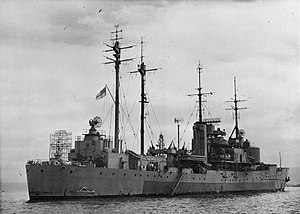Landing Ship Tank

Bren Gun Carriers being loaded at Bone Harbour through the bow doors of HMS Bachaquero
|
|
| Class overview | |
|---|---|
| Name: | LST Maracaibo class |
| Builders: | Furness Shipbuilding Company, Haverton Hill-on-Tees |
| Operators: |
|
| Succeeded by: | Boxer |
| Completed: | 3 (Misoa, Tasajera & Bachaquero) |
| General characteristics | |
| Tonnage: | 4,800 long tons (4,877 t) GRT |
| Length: | 382 ft (116 m) |
| Beam: | 64 ft |
| Draught: |
|
| Ramps: | Double hinged ramp, effective length of 100 ft (30 m) |
| Propulsion: | Reciprocating steam engine, 2 shafts, 3,000 shp |
| Capacity: | 18 × 30 ton tanks or 22 × 25 ton tanks or 33 × 3-ton trucks |
| Troops: | Berths for 217 troops |
| Complement: | 98 Combined Operations personnel |
| Armament: |
|
| Notes: | Equipment: 2 × 50 ton derrick cranes |

Boxer as Fighter Direction Ship
|
|
| Class overview | |
|---|---|
| Name: | LST (1) Boxer class |
| Builders: | Harland and Wolff |
| Operators: |
|
| Preceded by: | Maracaibo |
| Succeeded by: | LST (2) |
| Completed: | 3 (Boxer, Bruiser, Thruster) |
| General characteristics | |
| Type: | Landing Ship, Tank Mark I |
| Displacement: | |
| Length: | 400 ft (120 m) |
| Beam: | 49 ft (15 m) |
| Draught: | 14 ft 6 in (4.42 m) |
| Propulsion: | Steam turbines, 2 shafts, 7,000 shp (5,200 kW) |
| Speed: | |
| Range: | 9,000 nmi (17,000 km; 10,000 mi) at 14 kn (26 km/h; 16 mph) |
| Capacity: | 13 Churchill tanks or 20 medium tanks, 27 vehicles on upper deck, 193 men |
| Complement: | 169 |
| Armament: |
|
| Notes: | Equipment: 1 × 40 ton crane |

LST-942 underway soon after completion, late in 1944
|
|
| Class overview | |
|---|---|
| Name: | LST (2) |
| Operators: | |
| Subclasses: |
|
| Completed: | c. 1000 |
| General characteristics | |
| Displacement: |
|
| Length: | 327 ft 9 in (99.90 m) |
| Beam: | 50 ft (15 m) |
| Draught: |
|
| Propulsion: | 2 × General Motors 12-567 diesel engines, two shafts, twin rudders |
| Speed: | 12 knots (14 mph; 22 km/h) |
| Boats & landing craft carried: |
2 to 6 LCVPs |
| Troops: | About 140 officers and other ranks |
| Complement: | 8 to 10 officers, 100 to 115 enlisted |
| Armament: |
|
| Class overview | |
|---|---|
| Name: | LST (3) |
| Builders: | R & W. Hawthorn, Leslie & Co. Ltd, Harland and Wolff, Swan, Hunter & Wigham Richardson Ltd, Vickers-Armstrongs |
| Operators: | |
| Planned: | 119 |
| Completed: |
|
| Cancelled: | 40 + 6 scrapped before completion |
| Active: | 0 |
| Preserved: | 0 |
| General characteristics | |
| Displacement: |
|
| Length: | 347 ft (106 m) o/a |
| Beam: | 55 ft 2 in (16.81 m) |
| Draught: |
|
| Ramps: | 23 feet by 14 feet ramp |
| Propulsion: | Twin screws, steam reciprocating engines, 5,500 hp (4,100 kW), 10 ft (3.0 m) propeller |
| Speed: | 13 knots (24 km/h; 15 mph) |
| Capacity: | 10 tanks plus 15 vehicles |
| Troops: | 13 officers and 150 men |
| Complement: | 14 officers and 90 men |
| Armament: | 8 × 20 mm Oerlikon for A/A defence on some ships |
Landing Ship, Tank (LST), or tank landing ship, is the naval designation for ships built during World War II to support amphibious operations by carrying tanks, vehicles, cargo, and landing troops directly onto an shore with no docks or piers. This provided amphibious assaults to almost any beach. The bow of the LST had a large door that would open with a ramp for unloading the vehicles. The LST had a special flat keel that allowed the ship to be beached and stay upright. The twin propellers and rudders had protection from grounding. The LSTs served across the globe during World War II including: Pacific War and European theatre.
The first tank landing ships were built to British requirements by converting existing ships, then the British and US collaborated upon a joint design. Over 1,000 LSTs were laid down in the United States during World War II for use by the Allies. Eighty more were built in the United Kingdom and Canada.
The British evacuation from Dunkirk in 1940 demonstrated to the Admiralty that the Allies needed relatively large, ocean-going ships that could handle shore-to-shore delivery of tanks and other vehicles in amphibious assaults upon the continent of Europe. As an interim measure, three 4,000- to 4,800-GRT tankers, built to pass over the restrictive bars of Lake Maracaibo, Venezuela, were selected for conversion because of their shallow draft. Bow doors and ramps were added to these ships, which became the first tank landing ships, "LST (1)": HMS Misoa, Tasajera and Bachaquero. They later proved their worth during the invasion of Algeria in 1942, but their bluff bows made for inadequate speed and pointed out the need for an all-new design incorporating a sleeker hull.
...
Wikipedia
